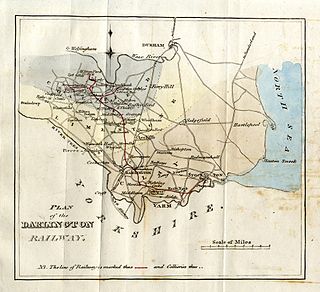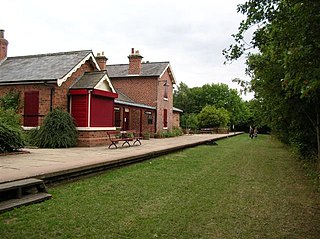
The Stockton and Darlington Railway (S&DR) was a railway company that operated in north-east England from 1825 to 1863. The world's first public railway to use steam locomotives, its first line connected collieries near Shildon with Darlington and Stockton in County Durham, and was officially opened on 27 September 1825. The movement of coal to ships rapidly became a lucrative business, and the line was soon extended to a new port at Middlesbrough. While coal waggons were hauled by steam locomotives from the start, passengers were carried in coaches drawn by horses until carriages hauled by steam locomotives were introduced in 1833.

The Durham Coast Line is an approximately 39.5-mile (63.6 km) railway line running between Newcastle and Middlesbrough in North East England. Heavy rail passenger services, predominantly operated Northern Trains, and some freight services operate over the whole length of the line; it provides an important diversionary route at times when the East Coast Main Line is closed. Light rail services of the Tyne and Wear Metro's Green Line also operate over the same tracks between a junction just south of Sunderland station and Pelaw Junction.
Cassop-cum-Quarrington is a civil parish in County Durham, England. According to the 2001 census it had a population of 4,735, increasing to 5,219 at the 2011 census.

Billingham is a railway station on the Durham Coast Line, which runs between Newcastle and Middlesbrough via Hartlepool. The station, situated 10 miles 8 chains (16.3 km) north-west of Middlesbrough, serves the town of Billingham, Borough of Stockton-on-Tees in County Durham, England. It is owned by Network Rail and managed by Northern Trains.

Hartlepool is a railway station on the Durham Coast Line, which runs between Newcastle and Middlesbrough via Hartlepool. The station, situated 18 miles 5 chains (29 km) south-east of Sunderland, serves the port town of Hartlepool in County Durham, England. It is owned by Network Rail and managed by Northern Trains.

Bishop Auckland is a railway station that serves the market town of Bishop Auckland in County Durham, North East England, 11 miles 77 chains (19.3 km) north-west of Darlington. The station is the Western terminus of the Tees Valley Line, which links it to Saltburn via Darlington. It is owned by Network Rail and managed by Northern Trains.

North Road is a railway station on the Tees Valley Line, which runs between Bishop Auckland and Saltburn via Darlington. The station, situated 1 mile 23 chains (2.1 km) north-west of Darlington, serves the market town of Darlington in County Durham, England. It is owned by Network Rail and managed by Northern Trains.

The Clarence Railway was an early railway company that operated in north-east England between 1833 and 1853. The railway was built to take coal from mines in County Durham to ports on the River Tees and was a competitor to the Stockton and Darlington Railway (S&DR). It suffered financial difficulty soon after it opened because traffic was low and the S&DR charged a high rate for transporting coal to the Clarence, and the company was managed by the Exchequer Loan Commissioners after July 1834. An extension of the Byers Green branch was opened in 1839 by the independent West Durham Railway to serve collieries in Weardale.

Ferryhill railway station was located in Ferryhill, County Durham, Northeast England. It was located on what became the East Coast Main Line between Darlington and Durham, close to the junctions with several former branches, including the extant freight-only Stillington Line to Norton-on-Tees and Stockton.

Goswick railway station served the hamlet of Goswick, Northumberland, England from 1870 to 1964 on the East Coast Main Line.

Waskerley railway station, also known as Waskerley Park, served the village of Waskerley, County Durham, England from 1845 to 1859 on the Stanhope and Tyne Railway.

Greatham railway station served the village of Greatham in the Borough of Hartlepool, North East England, from 1841 to 1991 on what became the Durham Coast Line.

Norton-on-Tees railway station served the town of Norton, County Durham, England from 1877 to 1960, originally on the Port Clarence Branch of the Clarence Railway.

Belasis Lane railway station served the ICI Billingham Manufacturing Plant in the town of Billingham, County Durham, England from 1928 to 1964 on the Port Clarence branch of the former Clarence Railway which had become part of the London and North Eastern Railway by the time the station opened.

Coundon railway station was a railway station that served the villages of Coundon and New Coundon in County Durham, North East England from 1885 to 1939. It was located on the Bishop Auckland to Ferryhill of the North Eastern Railway (NER), an extension of the earlier Byers Green Branch of the Clarence Railway (CR).

Thorpe Thewles railway station was a stop on the Castle Eden branch of the North Eastern Railway (NER) from 1880 to 1931. It was located approximately 5 miles north of Stockton and was designed to serve the village of Thorpe Thewles and the civil parish of Grindon in Stockton-on-Tees, part of the Ceremonial County of Durham, North East England. Despite its name, the station was actually located further from the village of Thorpe Thewles than Carlton station on the main line of the Clarence Railway.

Wellfield railway station was a railway station that served the village of Wingate in County Durham, England. It was built by the North Eastern Railway (NER) on the route of the Hartlepool Dock & Railway (HD&R) to allow interchange between the existing line and their newly opened line from Stockton-on-Tees.

Stokesley railway station was a railway station built to serve the town of Stokesley in North Yorkshire, England. The station was on the North Yorkshire and Cleveland line between Sexhow and Ingleby, which opened in 1857. The line was extended progressively until it met the Whitby & Pickering Railway at Grosmont. It was closed in 1954 to passengers and eleven years later to goods. The station was located 16 miles (26 km) south of Stockton and 3.5 miles (5.6 km) west of Battersby station.

Hart railway station was a station that served the villages of Hart and Crimdon in County Durham, England.

Blaengarw railway station served the village of Blaengarw, in the historical county of Glamorgan, Wales, from 1902 to 1953 on the Garw Valley Railway.



















